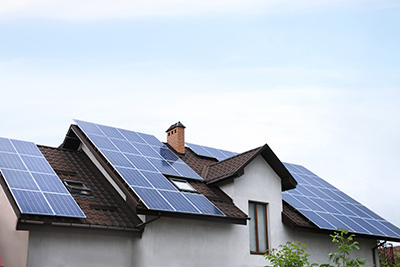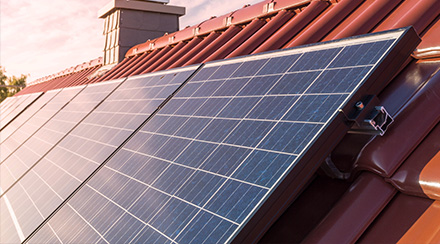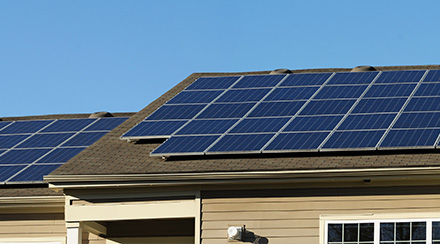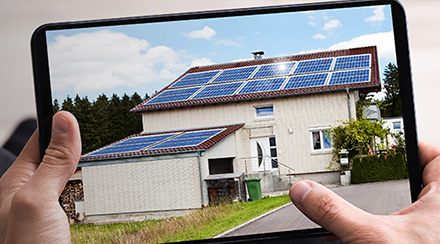The Different Types of Solar Panels
Going solar is one of the most powerful decisions you can make to save on energy costs and create a cleaner, healthier and more sustainable planet. But after you’ve resolved to install solar panels on your home, there are a few more important decisions to make, including which type of solar panel to choose.
Each type of solar panel has pros and cons, so it’s worth taking your time with this choice while weighing your budget, climate and energy needs.
Comparing the Types of Solar Panels

A qualified solar installer can help you decide which panels are most appropriate for your specific installation. The cost of solar equipment varies by manufacturer and model, and competition among solar installers adds even more cost variables depending on where you live, but for the typical residential rooftop project, the most common decision is between the higher cost, higher efficiency monocrystalline panels and the lower cost, lower efficiency polycrystalline panels. Here are the major factors to consider when comparing different types of solar panels.
Cost. As stated above, monocrystalline solar panels are generally more expensive than polycrystalline solar panels, but they also tend to last longer and come with longer warranties. The difference in price may also be negligible depending on the manufacturer, model and number of panels in the installation. Thin-film cells are often cheaper than polycrystalline panels, but these costs can also vary depending on the manufacturer. CdTe and a-Si film are comparably priced, with CIGS film costing more. Another factor to consider is that thin-film cells are so lightweight, they can sometimes be installed faster and with less mounting hardware, which can reduce installation costs.
Efficiency. Monocrystalline solar panels top the list with efficiency ratings between 15 and 20 percent, and sometimes higher. Polycrystalline solar panels are close behind with efficiency ratings between 15 and 17 percent. Thin-film cells rank lower, with 13 to 15 percent efficiency for CIGS film, nine to 11 percent efficiency for CdTe film and six to eight percent efficiency for a-Si film.
Space. How many solar panels to include in your home is one of many major decisions you'll encounter when installing solar panels. If you have limited space for solar panels, monocrystalline panels may be your best bet, because their high efficiency rating ensures you will get the most energy generation per square foot. On the other hand, if you have lots of available space, filling it with less efficient panels may generate sufficient electricity for your needs while saving you a bundle in upfront costs.
Roof type. All of these solar panel types can be installed on the average residential roof, but if you’re concerned about weight distribution on your roof, you should thoroughly investigate your thin-film cell options. The versatility of these lightweight, flexible materials means they can be installed in places where heavier crystalline panels are impractical. This includes solar shingles, which mimic the appearance of a traditional shingled roof.
Climate. High temperatures can have a negative effect on solar panel efficiency, so if you live in an especially warm environment, you should weigh this factor more heavily. Thin-film cells, while less efficient than crystalline panels, are more resistant to the negative effects of heat than crystalline panels. But the powerhouse monocrystalline solar panels are also fairly heat resistant, and with their higher efficiencies, they may perform best overall, especially in smaller installations. Polycrystalline solar panels fare the worst in extreme heat, and may therefore not be a smart choice for the hottest environments.
| Cost | Efficiency | Space | Roof type | Climate | |
|
Monocrystalline |
Most expensive |
15 to 20 percent |
Best choice for small spaces |
Good for most roofs |
Good performance in hot climates |
|
Polycrystalline |
Cheaper than monocrystalline |
15 to 17 percent |
Good for large solar arrays |
Good for most roofs |
Worst performance in hot climates |
|
Thin-film |
Often cheaper than polycrystalline; depends on type |
Six to 15 percent; depends on type |
Good for large solar arrays |
Best choice when weight is a concern |
Most resistant to hot climates |
No matter what type of solar panels you ultimately choose for your residential rooftop solar installation, you’ll be making an investment in a cleaner planet and lower energy bills. Consult with your solar installer and consider these variables to identify the solar panels that make the best fit for your roof, climate and budget.
What Are Solar Panels Made of?

Most solar panels fall into one of three categories: monocrystalline solar panels, polycrystalline solar panels and thin-film cells.
Monocrystalline solar panels are made from whole silicon crystals, which are sliced into thin wafers and assembled inside a glass-covered frame. Because of this construction method, they are the most efficient type of solar panel available, but they are also the most expensive to manufacture and purchase. The panel surface is usually a deep black color.
Polycrystalline solar panels also called multi-crystalline solar panels, are made by melting fragments of silicon crystals and pouring them into molds. These fragments are often the scraps that are left over from the manufacture of monocrystalline solar panels, and the composite crystals created from them are ultimately sliced into wafers and assembled similarly to their monocrystalline equivalents. This manufacturing process is cheaper, resulting in less expensive panels, but they are not as efficient as monocrystalline panels. The panel surface of polycrystalline solar panels is usually tinted blue.
Thin-film cells, also called amorphous solar panels, are less common in residential rooftop installations, but they are sometimes used for this and other solar power purposes. They are extremely lightweight and flexible, making them more versatile than panels made from silicon crystals, but they are less efficient than both monocrystalline and polycrystalline solar panels. Thin-film cells are made from one of three materials: cadmium telluride (CdTe), amorphous silicon (a-Si) and copper indium gallium selenide (CIGS). Each of these types have different price points, efficiency levels and common applications.
Looking for Something Specific?
Select a category to find resources for topics that interest you.
Select Category

Related Articles:

What Is Solar Energy and How Does it Work?
Thanks to rapidly advancing technology, a growing share of our energy comes from renewable sources like wind, hydropower and solar. Learn about solar energy and how it provides for homes and communities.
Read Article
How Do Solar Panels Work?
Rooftop solar panels are among the most visible symbols of a new energy future that is cleaner, healthier and more renewable. But do you know how solar panels work?
Read Article
How Much Do Solar Panels Cost?
All solar installations are customized based on the size, design and energy needs of the home, so there is no one-size-fits-all price. Let’s review the basic factors that affect the cost of solar installation.
Read ArticleThe Different Types of Solar Panels
Going solar is one of the most powerful decisions you can make to save on energy costs and create a cleaner, healthier and more sustainable planet. But after you’ve resolved to install solar panels on your home, there are a few more important decisions to make, including which type of solar panel to choose.
Each type of solar panel has pros and cons, so it’s worth taking your time with this choice while weighing your budget, climate and energy needs.
Comparing the Types of Solar Panels
A qualified solar installer can help you decide which panels are most appropriate for your specific installation. The cost of solar equipment varies by manufacturer and model, and competition among solar installers adds even more cost variables depending on where you live, but for the typical residential rooftop project, the most common decision is between the higher cost, higher efficiency monocrystalline panels and the lower cost, lower efficiency polycrystalline panels. Here are the major factors to consider when comparing different types of solar panels.
Cost. As stated above, monocrystalline solar panels are generally more expensive than polycrystalline solar panels, but they also tend to last longer and come with longer warranties. The difference in price may also be negligible depending on the manufacturer, model and number of panels in the installation. Thin-film cells are often cheaper than polycrystalline panels, but these costs can also vary depending on the manufacturer. CdTe and a-Si film are comparably priced, with CIGS film costing more. Another factor to consider is that thin-film cells are so lightweight, they can sometimes be installed faster and with less mounting hardware, which can reduce installation costs.
Efficiency. Monocrystalline solar panels top the list with efficiency ratings between 15 and 20 percent, and sometimes higher. Polycrystalline solar panels are close behind with efficiency ratings between 15 and 17 percent. Thin-film cells rank lower, with 13 to 15 percent efficiency for CIGS film, nine to 11 percent efficiency for CdTe film and six to eight percent efficiency for a-Si film.
Space. How many solar panels to include in your home is one of many major decisions you'll encounter when installing solar panels. If you have limited space for solar panels, monocrystalline panels may be your best bet, because their high efficiency rating ensures you will get the most energy generation per square foot. On the other hand, if you have lots of available space, filling it with less efficient panels may generate sufficient electricity for your needs while saving you a bundle in upfront costs.
Roof type. All of these solar panel types can be installed on the average residential roof, but if you’re concerned about weight distribution on your roof, you should thoroughly investigate your thin-film cell options. The versatility of these lightweight, flexible materials means they can be installed in places where heavier crystalline panels are impractical. This includes solar shingles, which mimic the appearance of a traditional shingled roof.
Climate. High temperatures can have a negative effect on solar panel efficiency, so if you live in an especially warm environment, you should weigh this factor more heavily. Thin-film cells, while less efficient than crystalline panels, are more resistant to the negative effects of heat than crystalline panels. But the powerhouse monocrystalline solar panels are also fairly heat resistant, and with their higher efficiencies, they may perform best overall, especially in smaller installations. Polycrystalline solar panels fare the worst in extreme heat, and may therefore not be a smart choice for the hottest environments.
| Cost | Efficiency | Space | Roof type | Climate | |
|
Monocrystalline |
Most expensive |
15 to 20 percent |
Best choice for small spaces |
Good for most roofs |
Good performance in hot climates |
|
Polycrystalline |
Cheaper than monocrystalline |
15 to 17 percent |
Good for large solar arrays |
Good for most roofs |
Worst performance in hot climates |
|
Thin-film |
Often cheaper than polycrystalline; depends on type |
Six to 15 percent; depends on type |
Good for large solar arrays |
Best choice when weight is a concern |
Most resistant to hot climates |
No matter what type of solar panels you ultimately choose for your residential rooftop solar installation, you’ll be making an investment in a cleaner planet and lower energy bills. Consult with your solar installer and consider these variables to identify the solar panels that make the best fit for your roof, climate and budget.
What Are Solar Panels Made of?
Most solar panels fall into one of three categories: monocrystalline solar panels, polycrystalline solar panels and thin-film cells.
Monocrystalline solar panels are made from whole silicon crystals, which are sliced into thin wafers and assembled inside a glass-covered frame. Because of this construction method, they are the most efficient type of solar panel available, but they are also the most expensive to manufacture and purchase. The panel surface is usually a deep black color.
Polycrystalline solar panels also called multi-crystalline solar panels, are made by melting fragments of silicon crystals and pouring them into molds. These fragments are often the scraps that are left over from the manufacture of monocrystalline solar panels, and the composite crystals created from them are ultimately sliced into wafers and assembled similarly to their monocrystalline equivalents. This manufacturing process is cheaper, resulting in less expensive panels, but they are not as efficient as monocrystalline panels. The panel surface of polycrystalline solar panels is usually tinted blue.
Thin-film cells, also called amorphous solar panels, are less common in residential rooftop installations, but they are sometimes used for this and other solar power purposes. They are extremely lightweight and flexible, making them more versatile than panels made from silicon crystals, but they are less efficient than both monocrystalline and polycrystalline solar panels. Thin-film cells are made from one of three materials: cadmium telluride (CdTe), amorphous silicon (a-Si) and copper indium gallium selenide (CIGS). Each of these types have different price points, efficiency levels and common applications.
Looking for Something Specific?
Select a category to find resources for topics that interest you.
Select Category

Related Articles:

What Is Solar Energy and How Does it Work?
Thanks to rapidly advancing technology, a growing share of our energy comes from renewable sources like wind, hydropower and solar. Learn about solar energy and how it provides for homes and communities.
Read Article
How Do Solar Panels Work?
Rooftop solar panels are among the most visible symbols of a new energy future that is cleaner, healthier and more renewable. But do you know how solar panels work?
Read Article
How Much Do Solar Panels Cost?
All solar installations are customized based on the size, design and energy needs of the home, so there is no one-size-fits-all price. Let’s review the basic factors that affect the cost of solar installation.
Read Article






